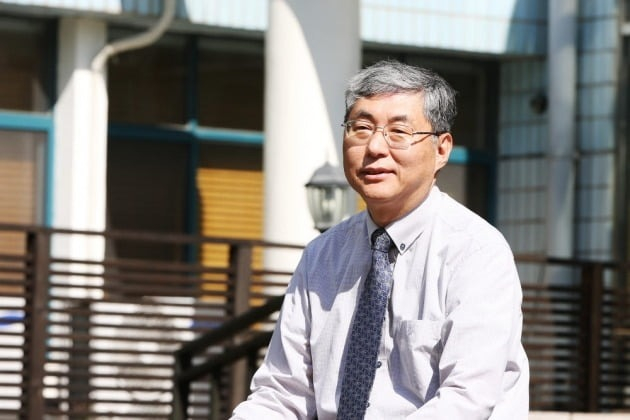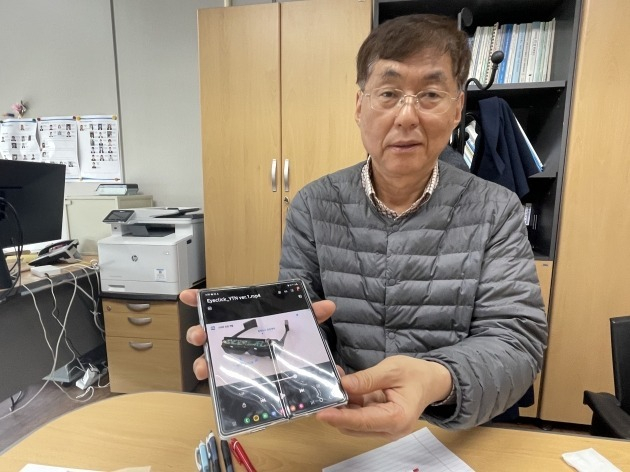Korean chipmakers
Korean research team develops AI chip to cut power use
The chip development leader says Korea needs to advance its technology to cut power consumption to dominate the global market
By Mar 26, 2023 (Gmt+09:00)
6
Min read
Most Read
Hankook Tire buys $1 bn Hanon Systems stake from Hahn & Co.


NPS to hike risky asset purchases under simplified allocation system


UAE to invest up to $1 bn in S.Korean ventures


Osstem to buy BrazilŌĆÖs No. 3 dental implant maker Implacil


US multifamily market challenges create investment opportunities



South Korean scientists have developed a chip that needs less electricity for advanced efficiency and data processing to help the countryŌĆÖs semiconductor industry maintain the throne in the worldŌĆÖs market amid the global buzz surrounding ChatGPT, a chatbot based on generative artificial intelligence technology.
A research team at Korea Advanced Institute of Science and Technology (KAIST), the countryŌĆÖs top science and research university, introduced the DynaPlasia, an analog processing-in-memory (PIM) chip, which integrates processing and memory with three transistors, at the 70th-anniversary ceremony of the International Solid-State Circuits Conference (ISSCC) last month.
The PIM chip, which improved efficiency and integration, needs less power than current chips, said the team leader Yoo Hoi-Jun, a KAIST electrical engineering professor.
The DynaPlasia is expected to help South KoreaŌĆÖs semiconductor industry maintain its dominance in the global market where AI is expanding its influence by developing technology to cut power consumption, said Yoo, who was recognized as a leading contributor to semiconductor design at the ISSCC. He was the only Asian out of the top five contributors.
ŌĆ£We can do it through semiconductors as everything including ChatGPT must use our chips. We have been accumulating knowledge and technology in the sector,ŌĆØ Yoo said when asked if South Korean chipmakers can succeed in the AI industry. ChatGPT is the global hit chatbot developed by Microsoft Corp.-backed OpenAI.
ŌĆ£It is core to important to develop semiconductors that reduce power consumption as we cannot suddenly increase electricity. Technology to cut power needs between memory and CPUs can be the first step to solving all the problems,ŌĆØ Yoo said, referring to central processing units.
ONLY SEMICONDUCTOR TO SUCCEED
He doubted South Korean major tech companies such as Naver Corp., the countryŌĆÖs top online portal, will be competitive enough to win the battle in the AI sector against global players.
ŌĆ£AI consists of three elements ŌĆō big data, algorithms and semiconductors for arithmetic operation,ŌĆØ Yoo said.
ŌĆ£Big Tech is dominating big data. Naver has large data, but it is smaller than GoogleŌĆÖs and difficult to keep up with the speed of data accumulation. Naver can make a model specialized in Korean, but it would be difficult if AI is advancing more.ŌĆØ Big Tech usually refers to the dominant companies in the information technology industry, notably the five top US firms ŌĆō Alphabet Inc. of Google, Amazon.com Inc., Apple Inc. Meta Platform Inc. and Microsoft.
South Korea does not have many companies that can afford the development algorithm, Yoo said.
ŌĆ£OpenAI, founded in 2015 by investments from Elon Musk and Microsoft, spent 800 billion won ($615.4 million) on equipment. That is how we can develop a new algorithm. It is hard to follow it.ŌĆØ
ANALOG PIM
PIM refers to the integration of a processor with Random Access Memory (RAM) on a single chip.
The existing computing, in which the memory chip with data and program and the CPU for arithmetic operation are separated, faces a bottleneck issue in the process of information transmission between the memory and the processor, Yoo said.
The problem becomes more serious when processing large data such as images and languages. The graphics processing unit (GPU) and neural processing unit (NPU) were developed to tackle the issue, but DRAM and those processors are still separate. PIM solves the issue.
The advanced chip is classified into two types ŌĆō digital and analog styles. The digital PIM has both memory chips and calculators but they are not fully integrated, Yoo said. Samsung Electronics Co. and SK Hynix Inc., the worldŌĆÖs two largest memory chipmakers, unveiled their own PIMs, but they are digital models, according to Yoo. Samsung introduced the HBM-PIM in 2021, while SK Hynix launched the AiM last year.
On the other hand, the analog PIM has millions of memory cells, each integrated with calculators, Yoo said. The DynaPlasia is the first analog PIM developed in South Korea.
ŌĆ£We developed it by introducing a dynamic reconfigurable core architecture, a method that changes the hardware structure in line with AI operations to increase efficiency and improve integration,ŌĆØ Yoo said.
ŌĆ£The idea was simple. With three transistors, it can become a memory chip, a calculator and an analog-digital converter, allowing users to use more for memory or more for calculations depending on what they need to process. Such transformation functions are expected to improve arithmetic operations and increase the degree of integration with less power.ŌĆØ
The DynaPlasia increased the integration by 27 times compared with the existing analog DRAM and 2.3 times compared with analog SRAM PIMs, Yoo said. The DynaPlasiaŌĆÖs throughput per chip is 15 times larger than those of digital PIMs, Yoo said.
The DynaPlasiaŌĆÖs arithmetic operation efficiency is 2.5 times higher when they are operated for AI than the existing analog PIMs with better efficiency by moving between memory chips and calculators and solving power leakage issues, he added.
LIFE FOR SEMICONDUCTOR
Yoo, the developer of the worldŌĆÖs first 256M SDRAM for Hyundai Electronics Industries Co., currently SK Hynix, 1995, started working on an embedded memory logic, a prototype of PIM, during the 1997-98 Asian financial crisis.
He developed the ramP for video games, which combined RAM and processors, and brought it to US chipmaker Nvidia Corp in 2003.
The semiconductor manufacturer, which had chips for games on PCs but not for mobile phones at that time, was surprised by the concept but not interested in it, saying ŌĆ£we may not need them as mobile phones have small screens,ŌĆØ according to Yoo.
His team had worked on the further development of the ramP for three to four years and made progress on a 3D graphics chip, but gave up the project as Nvidia started manufacturing GPUs, Yoo said.
He has been studying the combination of brain science and semiconductors since 2006 and developed NPUs for wearable devices.

The research has made considerable achievements while developing the K-Glass series, which detects usersŌĆÖ eye movements to point the cursor to recognize computer icons or objects on the Internet and uses winks for commands, Yoo said. The K-Glass 3 developed in 2016 was equipped with the first NPU that accelerates deep neural networks (DNNs), he added.
Yoo has been exclusively researching NPUs since then, developing into still image recognition, moving image recognition, and free movements in different functions, which are all linked to DynaPlasia.
ŌĆ£We are researching a semiconductor that is similar to human neurons. We continued to search for methods to work more with less power,ŌĆØ he said.
Write to Sang-Eun Lee at selee@hankyung.com
┬Ā
Jongwoo Cheon edited this article.
More to Read
-
 Artificial intelligenceNaverŌĆÖs HyperCLOVA X: More Korean-proficient than ChatGPT
Artificial intelligenceNaverŌĆÖs HyperCLOVA X: More Korean-proficient than ChatGPTFeb 28, 2023 (Gmt+09:00)
1 Min read -
 Korean chipmakersSamsung, SK Hynix: key beneficiaries of ChatGPT fever
Korean chipmakersSamsung, SK Hynix: key beneficiaries of ChatGPT feverFeb 13, 2023 (Gmt+09:00)
4 Min read
Comment 0
LOG IN


